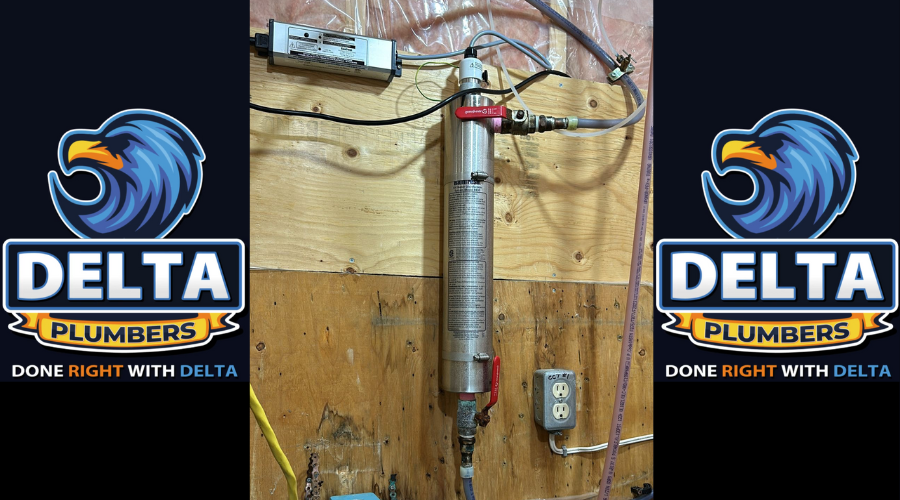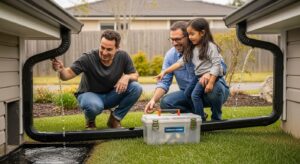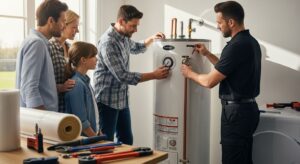Water pressure plays a significant role in the functionality and comfort of your home’s plumbing system. Whether you’re taking a shower, washing dishes, or watering the garden, consistent water pressure is essential. Unfortunately, many homeowners face issues with low water pressure, leading to frustration and inefficiency. In this comprehensive guide, we will explore how to improve your home’s water pressure, identify common causes of low water pressure, and offer practical solutions. We’ll also address specific questions such as how to check your home’s water pressure, where the water pressure regulator is located, and whether a plumber can help boost your water pressure.

Picture Source – Delta Plumbers
How Can I Get Higher Water Pressure in My House?
Improving water pressure in your home can be straightforward or may require more involved steps depending on the underlying cause. Below are several ways to increase water pressure in your home:
1. Inspect and Clean Fixtures
Over time, faucets and showerheads can accumulate mineral deposits, rust, and debris, which restrict water flow and lower pressure. Cleaning or replacing these fixtures can often result in an immediate improvement in water pressure. To clean a faucet or showerhead:
- Remove the fixture and soak it in a solution of white vinegar and water for several hours to dissolve mineral deposits.
- Scrub the interior with a brush to remove any remaining debris.
- Reattach the fixture and check if the water pressure has improved.
2. Check the Main Water Valve
Sometimes, low water pressure is due to the main water valve not being fully open. The main water valve controls the flow of water into your home, and if it’s partially closed, it can reduce water pressure significantly. To ensure it’s fully open:
- Locate the main water valve, usually found where the water line enters the house, typically in the basement or utility room.
- Turn the valve counterclockwise until it stops to ensure it’s fully open.
3. Install a Pressure Booster
If your home consistently suffers from low water pressure, installing a pressure booster pump may be the best solution. A booster pump increases water pressure by adding extra force to the water as it enters your home from the main supply. This can be particularly beneficial if your home is located at the end of a water supply line or in an area with generally low municipal water pressure.
- Contact a professional plumber to evaluate your system and install a suitable booster pump.
- The plumber can help you choose the correct size and type of pump for your home’s needs.
4. Upgrade Plumbing Pipes
Older homes often have outdated plumbing pipes made from materials like galvanized steel, which can corrode and reduce water flow over time. Replacing old pipes with newer materials such as copper or PEX can significantly improve water pressure.
- A licensed plumber can inspect your plumbing system and recommend necessary upgrades.
- Pipe replacement is a more involved process but can have a dramatic impact on water pressure and overall water quality.
Also Read: Winterize Your Plumbing System: How to do it?

Picture Source – Delta Plumbers
How Do I Equalize the Water Pressure in My House?
Unequal water pressure between different faucets and fixtures can be frustrating and may indicate an underlying issue in your plumbing system. Here’s how you can equalize water pressure throughout your home:
1. Check for Pipe Blockages
Partial blockages in your plumbing pipes can cause water pressure to vary between fixtures. Sediment buildup, corrosion, or debris in the pipes can restrict water flow and create pressure imbalances.
- A plumber can use specialized equipment to inspect and clear blockages in your pipes.
- Regular pipe maintenance and flushing can help prevent blockages and ensure consistent water pressure.
2. Install Pressure Balancing Valves
Pressure balancing valves can help equalize water pressure between different fixtures. These valves automatically adjust to changes in water pressure, ensuring that all fixtures receive a consistent flow of water.
- Pressure balancing valves are commonly installed in shower systems but can be used throughout the home.
- Consult with a plumber to determine the best locations for installing these valves.
3. Adjust the Pressure Regulator
If your home has a water pressure regulator, it may need adjustment to balance the pressure throughout the house. The regulator controls the pressure of water entering your home from the municipal supply.
- Locate the pressure regulator, typically found near the main water shutoff valve.
- Use a wrench to adjust the regulator’s screw, increasing or decreasing the pressure as needed.
- Be cautious not to set the pressure too high, as this can damage your plumbing system.
Also Read: Benefits of a Tankless Water Heater

Picture Source – Delta Plumbers
Why Is the Water Pressure So Bad in My House?
Understanding the root causes of low water pressure is essential for finding the right solution. Several factors can contribute to poor water pressure in your home:
1. Municipal Water Supply Issues
Sometimes, the issue isn’t within your home but with the municipal water supply. If your neighborhood is experiencing low water pressure, it can affect your home as well.
- Contact your local water supplier to inquire about any known issues or ongoing maintenance work that might be affecting pressure.
2. Leaking Pipes
Water leaks can significantly reduce water pressure in your home. As water escapes through leaks, less water reaches your faucets and fixtures.
- Look for signs of water damage, such as wet spots on walls, ceilings, or floors, and listen for sounds of dripping water.
- A plumber can locate and repair leaks in your plumbing system, restoring normal water pressure.
3. Corroded or Clogged Pipes
Older plumbing systems, especially those with galvanized steel pipes, can suffer from corrosion and clogs. This restricts water flow and leads to lower pressure.
- Replacing corroded pipes with modern materials can resolve this issue.
- Regular maintenance and pipe cleaning can prevent clogs and maintain good water pressure.
4. Faulty Pressure Regulator
A malfunctioning water pressure regulator can cause water pressure to be too low or too high. If the regulator fails, it may need to be repaired or replaced.
- Test the regulator by adjusting it as described earlier. If there’s no change in pressure, the regulator might be faulty.
5. Peak Water Usage Times
Water pressure can drop during peak usage times when many households in your area are using water simultaneously. This is more common in densely populated neighborhoods.
- Try using water during off-peak times, such as late at night or early in the morning, to see if pressure improves.
- Installing a pressure booster pump can also help mitigate this issue.
Also Read: Top 10 Plumbing Myths Debunked

Picture Source – Delta Plumbers
Can a Plumber Increase My Water Pressure?
Yes, a professional plumber can help you increase your home’s water pressure. Plumbers are trained to diagnose and resolve issues that cause low water pressure and can offer tailored solutions based on your specific needs. Here’s how a plumber can assist:
1. Diagnose the Problem
A plumber will conduct a thorough inspection of your plumbing system to identify the cause of low water pressure. This includes checking for leaks, blockages, and the condition of your pipes.
- Plumbers have specialized tools and equipment to accurately diagnose pressure issues that might not be visible to the homeowner.
2. Repair or Replace Pipes
If the issue is due to corroded or clogged pipes, a plumber can repair or replace them to restore normal water pressure. Upgrading your plumbing system can provide a long-term solution to pressure problems.
- The plumber will recommend the best materials for your pipes, such as copper or PEX, based on your home’s needs.
3. Install a Pressure Booster Pump
If your home’s location or the municipal supply is the root cause of low water pressure, a plumber can install a pressure booster pump. This pump increases the pressure of the water entering your home, ensuring a strong flow throughout your plumbing system.
- The plumber will select a pump that matches your home’s water usage and install it in the most effective location.
4. Adjust or Replace the Pressure Regulator
A plumber can adjust your water pressure regulator to ensure it’s set correctly for your home. If the regulator is faulty, they can replace it with a new one to maintain consistent water pressure.
- Proper adjustment of the regulator is crucial for balancing pressure across all fixtures.
Also Read: Emergency Plumbing Tips: What to Do When You Have a Leak

Picture Source – Delta Plumbers
How to Fix Low Water Pressure?
Fixing low water pressure involves identifying the cause and applying the appropriate solution. Here are steps you can take to resolve low water pressure issues:
1. Clean or Replace Fixtures
As mentioned earlier, mineral deposits and debris can clog faucets and showerheads, reducing water pressure. Cleaning or replacing these fixtures is a simple first step to fixing low water pressure.
2. Inspect and Repair Leaks
Leaks in your plumbing system divert water away from your fixtures, leading to reduced pressure. Inspect your home for signs of leaks, such as water stains, damp spots, or unexplained increases in your water bill.
- Repairing leaks can involve anything from tightening connections to replacing sections of pipe. A plumber can assist with more complex repairs.
3. Check the Pressure Regulator
If your home has a water pressure regulator, ensure it’s functioning correctly. Adjust the regulator as needed to increase pressure, or replace it if it’s faulty.
4. Flush Your Water Heater
Sediment buildup in your water heater can reduce water pressure, particularly in hot water fixtures. Flushing the water heater can remove this buildup and restore pressure.
- To flush the water heater, turn off the power supply, attach a hose to the drain valve, and let the water flow out until it runs clear. Refill the heater and check the pressure.
5. Contact a Plumber
If you’ve tried the above steps and still experience low water pressure, it’s time to call a professional plumber like Delta Plumbers. They can conduct a thorough inspection and recommend more advanced solutions, such as installing a booster pump or upgrading your plumbing system.
Also Read: Green Plumbing Solutions: Eco-Friendly Tips for Your Home

Picture Source – Delta Plumbers
How to Check Water Pressure in Home?
Checking your home’s water pressure is a simple task that requires only a few tools. Here’s how you can do it:
1. Purchase a Water Pressure Gauge
A water pressure gauge is an inexpensive tool that you can find at most hardware stores. It measures the water pressure in your home in pounds per square inch (PSI).
- Choose a gauge with a range that includes 0 to 100 PSI for the most accurate reading.
2. Locate an Outdoor Faucet
To check your home’s water pressure, you’ll need to attach the gauge to an outdoor faucet or a laundry faucet. These locations are ideal because they connect directly to your home’s main water line.
- Make sure no water is being used inside the house when you perform the test, as this can affect the reading.
3. Attach the Gauge and Turn on the water
Screw the pressure gauge onto the faucet, ensuring it’s securely attached to prevent leaks. Once it’s in place, turn on the faucet fully to get a reading.
- The gauge will display the water pressure in PSI. Normal water pressure for a home should be between 40 and 60 PSI.
4. Interpret the Results
- Low Pressure: If your water pressure is below 40 PSI, it’s considered low, and you may need to take steps to increase it.
- High Pressure: If the pressure is above 60 PSI, it may be too high, potentially leading to plumbing damage. A pressure regulator may need adjustment.
- Record the pressure reading and, if necessary, consult a plumber for further evaluation.
Also Read: Right Plumber for Your Needs: How to Choose Best

Picture Source – Delta Plumbers
Where Is the Water Pressure Regulator Located in a Home?
A water pressure regulator is a device that controls the pressure of water entering your home from the municipal supply. It ensures that the pressure remains at a safe and consistent level. Here’s how to locate it:
1. Check Near the Main Water Shutoff Valve
The water pressure regulator is typically located near the main water shutoff valve, where the water line enters your home. This is usually in the basement, utility room, or garage.
- Look for a brass or bronze valve with a bell-shaped body and an adjustable screw on top. This is your pressure regulator.
2. Inspect Outside Your Home
In some cases, the regulator might be located outside, particularly in warmer climates where plumbing systems aren’t installed inside the home. Check near the exterior walls where the main water line enters your home.
3. Consult Your Home’s Blueprints or Plumbing Diagram
If you’re having trouble locating the pressure regulator, you can refer to your home’s blueprints or plumbing diagram. These documents should indicate the location of major plumbing components, including the pressure regulator.
- If you don’t have access to these documents, a professional plumber can help you locate and assess the regulator.
Conclusion
Improving your home’s water pressure involves understanding the underlying causes and applying targeted solutions. Whether it’s cleaning fixtures, adjusting the pressure regulator, or installing a pressure booster pump, there are several ways to ensure your home’s water pressure meets your needs. Regular maintenance and timely repairs are key to preventing pressure issues and keeping your plumbing system in top condition.
If you’re experiencing persistent low water pressure, don’t hesitate to contact a professional plumber. They can diagnose the problem, recommend effective solutions, and ensure that your home’s water pressure is optimized for comfort and efficiency. Delta Plumbers is here to help with all your plumbing needs, providing expert service and advice to keep your water pressure at its best.









